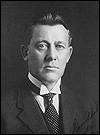James Thomas Milton Anderson
James Thomas Milton Anderson (July 23, 1878 – December 29, 1946) was the fifth Premier of Saskatchewan and the first Conservative to hold the office.
James Thomas Milton Anderson | |
|---|---|
 | |
| 5th Premier of Saskatchewan | |
| In office September 9, 1929 – July 19, 1934 | |
| Monarch | George V |
| Lieutenant Governor | Henry William Newlands Hugh Edwin Munroe |
| Preceded by | James Garfield Gardiner |
| Succeeded by | James Garfield Gardiner |
| Member of the Legislative Assembly of Saskatchewan for Saskatoon City | |
| In office June 2, 1925 – June 19, 1934 | |
| Preceded by | Harris Turner |
| Succeeded by | James Wilfred Estey George Wesley Norman |
| Personal details | |
| Born | July 23, 1878 Fairbank, Ontario (now a neighbourhood of Toronto) |
| Died | December 29, 1946 (aged 68) Saskatoon, Saskatchewan |
| Political party | Conservative |
| Residence | Saskatoon |
| Profession | Lawyer |
Anderson was chosen leader of the Conservatives in 1924, and was one of three Tory Members of the Legislative Assembly elected in the 1925 election.
In the 1929 election, the Tories were able to exploit patronage scandals surrounding the Liberal government of Premier Jimmy Gardiner to achieve a major breakthrough – winning 24 seats. The Liberals won 28 seats, while 5 went to the Progressive Party, and the remaining 4 to independents. The Liberals tried to form a minority government, but were defeated in a Motion of No Confidence. This allowed Anderson to form a "Co-operative government", a coalition between the Tories, Progressives and Independents.
Anderson was accused of working closely with the Ku Klux Klan, which was a major force in the province in the late 1920s and early 1930s with an estimated 25,000 members. Pat Emmons, a senior Klan defector, alleged that Anderson and Klan officials would regularly meet; while the Liberals accused the Tories of being a front for the Klan. With few Blacks in the province, and First Nations largely confined to Indian reserves under the informal pass system, the focus of the KKK was against immigration, Catholics and French Canadians – and opposition to the Gardiner Liberals, who were seen as supporting all three.
While Anderson denied the allegations, upon gaining power he took the portfolio of Minister of Education as well as Premier and proposed amendments to the Schools Act to ban the instruction of French in public schools, and outlaw the display of religious symbols in all schools – including the Catholic Separate School system. The KKK supported these changes, and worked hard to elect and defend the Conservative-dominated government.
The Anderson government also had to face the onset of the Great Depression and dust bowl that destroyed the province's agrarian economy. Anderson also had to deal with labour unrest culminating in the Estevan Riot of 1931. The government formed the Saskatchewan Relief Commission to try to help those affected by the drought and massive unemployment. These efforts were insufficient; and in the 1934 elections, the Tories lost every seat in the legislature, and remained a minor party for forty years.
Sources
- Encyclopedia of Saskatchewan
- The Canadian Encyclopedia
- Saskatchewan Archives Board – Saskatchewan Election Results By Electoral Division
| Party political offices | ||
|---|---|---|
| Preceded by Donald Maclean |
Leader of the Conservative Party of Saskatchewan 1924–1936 |
Succeeded by John Diefenbaker |